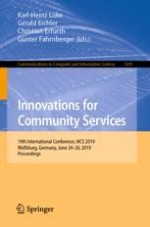2019 | Buch
Innovations for Community Services
19th International Conference, I4CS 2019, Wolfsburg, Germany, June 24-26, 2019, Proceedings
herausgegeben von: Prof. Dr. Karl-Heinz Lüke, Gerald Eichler, Prof. Dr. Christian Erfurth, Günter Fahrnberger
Verlag: Springer International Publishing
Buchreihe : Communications in Computer and Information Science
